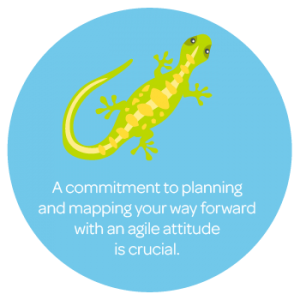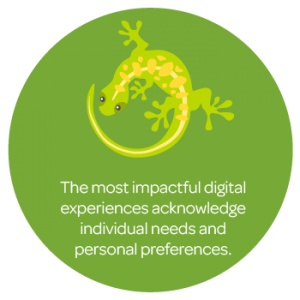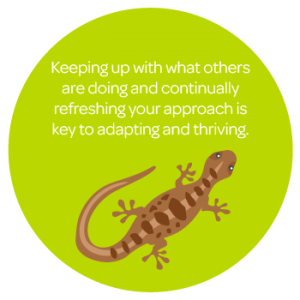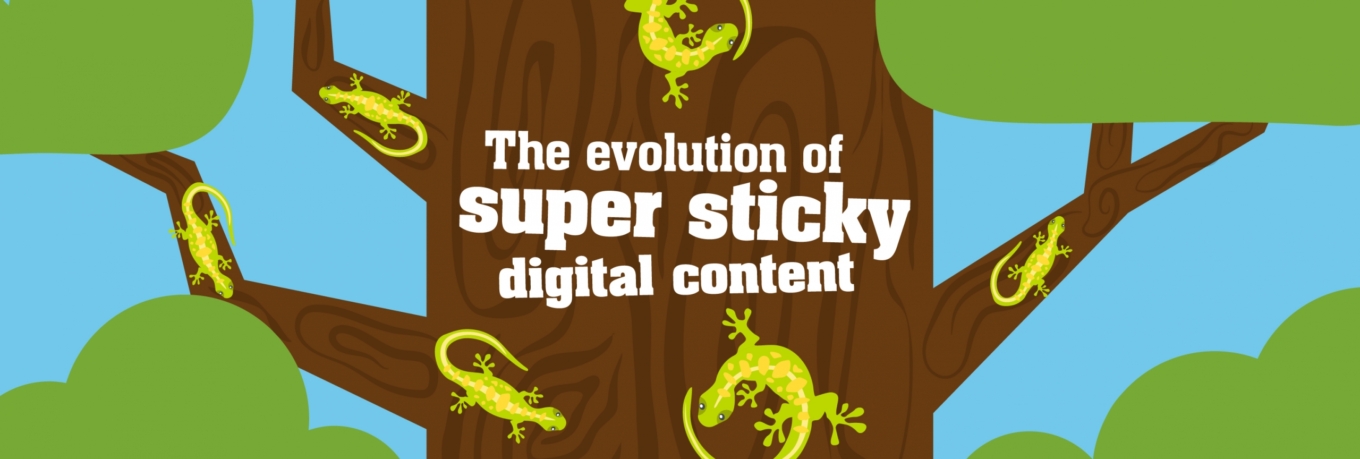We sometimes think of evolution as a thing of the past – the territory of dinosaurs – but constant changes around us continue to force us to adapt to thrive.
Just like the native green lizards that hang out in the lower branches of Florida’s trees. Their noses were put out of joint when their cheeky cousins, the brown lizards moved in. The green lizards reacted by abandoning the lower branches for the treetops which are thinner and smoother, so their bodies adapted. To cling to the smooth branches, they evolved. Their toepads grew bigger and stickier, allowing them to thrive up high.
There’s a vital lizardy lesson for comms pros here – adapt or you’re on a slippery slope down a bumpy tree…
“Developing great digital content is vital to engage with your staff. The majority of employees own smartphones, use social media and constantly see great (as well as rubbish) content. We’re bombarded with 10k-plus messages each day,” says Darren Caveney, creator of the communications industry resource Comms2Point0 and digital communications specialist.
“They’ll see and hear it at lunch, on the commute and at home every night. That’s serious competition.”
So put your internal work in that context and our content needs to work much harder to stand out in a crowded market.
Like those lizards, we must adapt the way we do things. The fundamentals of quality content remain true, but the following points can help us to consider how our content can and must evolve.
Strategy must be king of your jungle
Like most aspects of comms, content must be based on a consistent and creative strategy that’s built on insightand research and linked to your organisation’s aims. Form that strategy around evergreen content, but allow for the flexibility to adapt, repurpose and respond to the inevitable updates and topical changes. The beauty of digital lies in the ability to use data to refine and improve your content as you go.
A commitment to planning and mapping your way forward with an agile attitude is crucial.
Reflect natural habitats
Where do your audiences prefer to consume their content?
Do you know how much is viewed on mobile versus pc?
Which of your channels are busiest and at what times of the day?
The most impactful digital experiences acknowledge individual needs and personal preferences. Digital content engages on their terms, when it suits them most. Take advantage of the ability to segment your stakeholders and tailor your content according to where, when and what gets them going. Then inspire individual readers with a clear goal and know what will make them leap into action as a result.
Preserve environments by owning your own platforms
“As social platforms continue to evolve and ‘probably’ charge us increasingly in the future I worry about how much internal channels are invested in platforms like Facebook at Work,” says Darren. “I can see all the benefits such platforms offer – staff awareness, relative ease of use, employees engaging with each other naturally and without the comms team having to direct everything of course appeals.
But what happens in two years when prices have gone up and budgets have gone down?
Owning our own platforms is vital. Every organisation will be different but if you have an intranet then it should offer first-class content and if you email employees then treat it like you would an important external campaign.”
Expose a human side
The benefits of face-to-face contact can be lost through digital media. Developing a human face to the content you share can help to overcome this. Organisations need to show authenticity and personality and this can be reflected in their content.
Show who you are by dropping the barriers of industry language and polished, unnatural images. Share stories that show what’s important to your organisation, build trust through your content by showing what you stand for and align your values with your audiences’.
This video from Mansfield Police demonstrates the point beautifully as an officer plays the piano for an elderly crime victim. Human, heartwarming and perfectly unpolished… (super spot, Dan Slee 😉 )
https://www.youtube.com/watch?v=dpxYcU2Q-nc#action=share
Push the boundaries to cut through the swamp
The digital landscape is literally swamped with content – for it to cut through, it needs to be creative, offering its audience a reason why it deserves their interest. Take the initiative to disrupt the status quo and do something unexpected…
Rather than creating run-of-the-mill comms around IT security, we created this animation for the University of Manchester’s Cyber Security Campaign – something that would stand out, convey IT security messages in a new and engaging way and create an immediate sense of intrigue.
Adapt, adapt, adapt
Research, analyse, look beyond your industry, find out what’s working where and try new things. Keeping up with what others are doing and constantly refreshing your approach is a key element of adapting and thriving. It is our job as communicators to limber up and scale that tree like nimble lizards, remaining agile and adapting to the changes we face.
In fact, not keeping pace could be downright dangerous for your organisation. “The cost of falling behind with how people want to consume media is that your organisation will be at best irrelevant and at worst seen to be actively not caring,” writes Dan Slee in this recent post on Comms2Point0 about comms predictions for 2018.
“For our digital content to continue evolving effectively we need to use the data and metrics available to us to refine the media we’re creating, check what works and what doesn’t, stop sharing content that doesn’t engage and start testing new things.”
Grow slow, evolution won’t occur overnight
“Give yourself time to succeed,” says Darren. “Through the Comms2Point0 UnAwards I’m fortunate to be able to see the very best internal work around. One of the common themes of the best work submitted is that the team have made proper time to be creative, to think, to test, to launch, refine and review. It can’t be done with a five minute update on the intranet. Easier said than done? That is where demand management and genuine organisational prioritisation comes in.”
Embracing digital means adopting a fearless approach to testing and learning,
trying new things, helping two-way dialogue to happen and leaving those bygone brown lizards behind.
Although the differences between how we communicate through traditional media and the digital landscape can often be subtle ones – quality over quantity, strong messaging and audience empowerment will always apply – adopting the points above will help to keep us at the top of our tree.
















